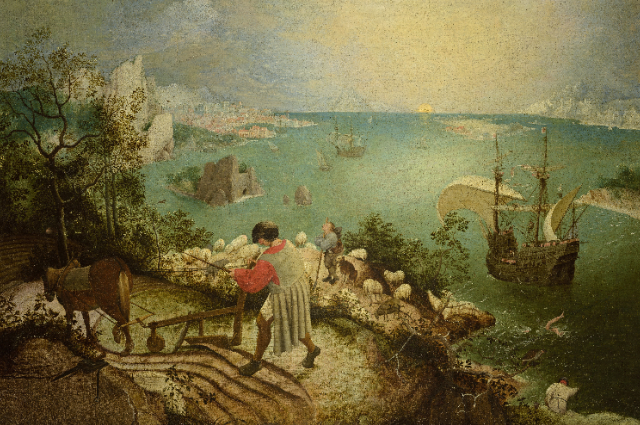Landscape with the fall of Icarus is an intricate oil painting said to have been painted by Pieter Bruegel, the Elder. The painting at first sight depicts a ploughman, a shepherd, and a fisherman that can ideally be regarded as the primary occupational expectations of that time. The shepherd is watching the sky with blue and yellow hue. The glance beholds a God-like creature that has spread its wings as though it has emerged from the depths of the sky. The man has become a phoenix in man’s perception, the blindness of common man has created an image of a God-like being, when in reality, it is just another man with feathered wings stuck together with beeswax. Daedalus is in flight and his son Icarus is nowhere to be seen. Looking deeper, a man appears to be drowning, the strokes of the paintbrush create an aura of struggle. At first glance, the fisherman is painted with more sincerity, while the drowning man is painted in controversy. Not one of the common occupational men have spared a moment for the man that is drowning. It implies a situation in which those admiring the art with no prior knowledge of the myth the painting revolves around, have to question whether the man is truly drowning, as it is shocking to believe that no one has paid heed to the struggling man. Icarus no longer had the wings that his father Daedalus had made for the both of them to escape the Island of Crete. Icarus flew too close to the sun and plunged to his death. Why?
The myth revolving around the tragic fall of Icarus begins with the plight of his father. Daedalus had worked as an artisan back when he was in Athens. In a sudden upsurge of anger and jealousy, Daedalus pushed his apprentice Talus off the rock of Acropolis with the intent of having him killed, but Talus survived. The Goddess Athena then transformed him into a bird. Daedalus was deemed a murderer and was sent to Crete to take refuge. On the island, Daedalus had his son; Icarus. Later, under the jurisdiction of King Minos, Daedalus was asked to create a space to contain the Minotaur that inhabited the island, which explains the large bodies of water emphasized in the canvas. Daedalus created a complex labyrinth to hide the Minotaur instead. The genius creation was recognized as a maze articulated with perfection in which one that entered could never escape. The maze may be the domes of stone that can be seen in the distance within the painting. But the existence of the Minotaur was not known to most of the islanders and Daedalus’ creation would reveal this secret. And so, Daedalus and his family were locked up. Daedalus emerged from his pool of cunning thought and creativity and devised a plan to escape with the feathers of the birds that circled the island and stuck them together with wax. And incredibly, they flew. Daedalus warned Icarus not to fly too close to the sun, nor too close to the sea but to follow his path of flight. Consequentially, caused by the mistakes of Daedalus; which Icarus appears to be unaware of, as that is in the past. Having been locked up in the labyrinth for days, the prospect of flight with feathered wings alone, created a new vision of ecstasy which was not known to the creator let alone the commoners. And so, the shepherd continued to watch Daedalus fly. Blinded by the illusions of beauty, reality faltered and resulted in Icarus’ demise. As he flew closer to the sun, every inch of his wings burned into nothingness until he appeared mere human and drowned.
In the painting, ironically, there is a bird seated on a branch seemingly watching the fisherman in hopes of fish being caught. And the chances of the bird being Talus cannot entirely be disregarded. The presence of Talus witnessing the fall of Icarus is held in irony as Talus too had fallen as he had been pushed by Daedalus. Furthermore, Daedalus had used feathers of birds to escape the island, and Talus had been turned into a bird by Athena after he had fallen.
Noticeably, the ships and the boats also appear to be moving away from the incident. The farmer continues to plough, the fisherman continues to fish, and the shepherd is still mesmerized by the sight of Daedalus. It portrays the ignorance of man to fellow men’s suffering. Even the dog and the flock of sheep are not disturbed by the scenery of Icarus drowning. Even if it occurred in spontaneity. Only Daedalus watches as his son drowns below the ship.
In conclusion, Daedalus warned Icarus of “complacency” and “hubris”; both of which had been defied and violated in varying magnitudes by Daedalus in his past. And at present, Icarus in his innocence and freedom had apparently “disobeyed” his father. And thus, the implications of the bird which can serve as a reminder of Daedalus’ past and every other detail from the vast seas and islands to the cup next to the fisherman and the spot of light behind the tallest tree have its place of intricacy in its mythic art. The oil painting itself has captured the story leading to the fall of Icarus and the fall itself with immense precision and tragic beauty.

